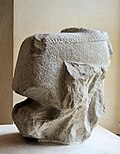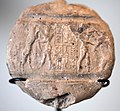Awan dynasty
| Awan dynasty 𒈗𒂊𒉈𒀀𒉿𒀭𒆠 lugal-e-ne a-wa-anki | |
|---|---|
Awan dynasty | |
| Current region | Elam |
Elamites remained a major source of tension after Awan's defeat | |
The Awan Dynasty (
Elam and Sumer
According to the Sumerian King List, a dynasty from Awan exerted hegemony in Sumer after defeating the First Dynasty of Ur, probably in the 25th century BCE.[8] It mentions three Awan kings, who supposedly reigned for a total of 356 years.[9] Their names have not survived on the extant copies, apart from the partial name of the third king, "Ku-ul...", who it says ruled for 36 years.[10] This information is not considered reliable, but it does suggest that Awan had political importance in the 3rd millennium BC.
A royal list found at
As there are very few other sources for this period, most of these names are not certain. Little more of these kings' reigns is known, but Elam seems to have kept up a heavy trade with the Sumerian city-states during this time, importing mainly foods, and exporting cattle, wool, slaves and silver, among other things. A text of the time refers to a shipment of tin to the governor of the Elamite city of Urua, which was committed to work the material and return it in the form of bronze — perhaps indicating a technological edge enjoyed by the Elamites over the Sumerians.
It is also known that the Awan kings carried out incursions in Mesopotamia, where they ran up against the most powerful city-states of this period, Kish and Lagash. One such incident is recorded in a tablet addressed to Enetarzi, a minor ruler or governor of Lagash, testifying that a party of 600 Elamites had been intercepted and defeated while attempting to abscond from the port with plunder.[14]
Events become a little clearer at the time of the
Sargon's son and successor,
With these defeats, the low-lying, westerly parts of Elam became a vassal of Akkad, centred at Susa. This is confirmed by a document of great historical value, a peace treaty signed between Naram-Sin of Akkad and an unnamed king or governor of Awan, probably Khita or Helu. It is the oldest document written in Elamite cuneiform that has been found.
Although Awan was defeated, the Elamites were able to avoid total assimilation. The capital of Anshan, located in a steep and mountainous area, was never reached by Akkad. The Elamites remained a major source of tension, that would contribute to destabilizing the Akkadian state, until it finally collapsed under Gutian pressure.
Reign of Kutik-Inshushinak(Puzur Inshushinak), the height of Awan
When the Akkadian empire started to break down around 2240 BC, it was
By this time, Susa had started to gain influence in Elam (later, Elam would be called Susiana), and the city began to be filled with temples and monuments. Kutik-Inshushinak next defeated Kimash and Hurtum (neighboring towns rebelling against him), destroying 70 cities in a day. Next he established his position as king, defeating all his rivals and taking Anshan, the capital. Not content with this, he launched a campaign of devastation throughout northern Sumer, seizing such important cities as
Kutik-Inshushinak's work was not only as a conqueror; he created Elam's organization and the administrative structure. He extended the temple of Inshushinak, where he erected a statue of her.
After his defeat, the Awan dynasty disappears from history, probably cut down by the Guti or Lullubi tribes that then sowed disorder in Mesopotamia and the Zagros, and Elam was left in the hands of the Shimashki dynasty.
Awan and Anshan?
The toponym "Awan" only occurs once more following the reign of Kutik-Inshushinak, in a year-name of Ibbi-Sin of Ur. The name Anshan, on the other hand, which only occurs once before this time (in an inscription of Manishtushu), becomes increasingly more commonplace beginning with king Gudea of Lagash, who claimed to have conquered it around the same time. It has accordingly been conjectured that Anshan not only replaced Awan as one of the major divisions of Elam, but that it also included the same territory.[15]
List of rulers of Awan
| # | Portrait or inscription | Ruler | Approximated date | Succession and death details | Notes and references for mentions |
|---|---|---|---|---|---|
| Awanite rulers mentioned on the Awanite King List | |||||
| 1. | 
|
Peli or Feyli | Uncertain, reigned c. 2800 – c. 2350 BC (?) | Unclear succession | |
| 2. | 
|
Tata | |||
| 3. | Ukku-Tanhish | ||||
| 4. | Hishutash | ||||
| 5. | Shushun-Tarana | ||||
| 6. | Napi-Ilhush | ||||
| 7. | Kikku-Siwe-Temti | ||||
| 9. | Hishep-Ratep | Uncertain, r. c. 2350 – c. 2254 BC (?) | temp.:
| ||
| 8. | 
|
Luh-ishan | Son of Hishep-Ratep (?) d. c. 2325 BC | ||
| 10. | Helu | Unclear succession | |||
| 11. | 
|
Khita | Uncertain, r. c. 2254 – c. 2200 BC (?) | temp.:
| |
| 12. | 
|
Puzur-Inshushinak | Uncertain, r. c. 2200 – c. 2090 BC (?) | Nephew of Khita (?) | temp.: |
| |||||
| # | Portrait or inscription | Ruler | Approximated date | Succession and death details | Notes and references for mentions |
| Akkadian governors and other Elamite rulers | |||||
| Sanam-Shimut | Uncertain, r. c. 2325 BC (?) | Unclear succession | temp.:
| ||
| Zinuba | Uncertain, r. c. 2315 BC (?) | ||||
| Lamgium | Uncertain, r. c. 2315 – c. 2254 BC (?) | temp.:
| |||
| Uba | |||||
| Ur-Ili-Adad[16] | |||||

|
Eshpum | ||||

|
Epirmupi | ||||
| Enammuna | |||||

|
Ili-ishmani[16] | Uncertain, r. c. 2254 – c. 2200 BC (?) | temp.:
| ||
| Shinpi-hish-huk[16] | |||||

|
Khita | ||||

|
Puzur-Inshushinak | Uncertain, r. c. 2200 – c. 2090 BC (?) | Nephew of Khita (?) | temp.:
| |
References
Citations
- ^ "Awan King List".
- ^ a b Scheil 1931.
- ^ a b Leick 2001, p. 99.
- ^ Gershevitch 1968, pp. 25–26.
- ^ Liverani 2013, p. 142.
- ^ Hansen & Ehrenberg 2002, p. 133.
- ^ Kriwaczek 2010, p. 136: "Then Urim was defeated and the kingship was taken to Awan."
- ^ Legrain 1922, pp. 10–22.
- ^ a b Stolper 1987.
- ^ Hinz 1972.
- ^ Cameron 1936.
- ^ Vallat 1998.
- ^ Kramer 1963, p. 331.
- ^ a b Hansman 1985.
- ^ a b c Legrain 1922, pp. 10–22.
Bibliography
- Cameron, G. (1936). History of Early Iran (Thesis). United States: ISBN 9780608165332.
- ISBN 9780190208820.
- Diakonoff, I. (1956). История Мидии От Древнейших Времен До Конца IV Века До Н.э. [The history of Media from ancient times to the end of the 4th century BCE] (in Russian). Moscow and Leningrad.
{{cite book}}: CS1 maint: location missing publisher (link) - ISBN 9780521070515.
- ISBN 9780521200912.
- Hansen, D.; Ehrenberg, E. (2002). Leaving No Stones Unturned: Essays on the Ancient Near East and Egypt in Honor of Donald P. Hansen. Eisenbrauns. ISBN 9781575060552.
- Hansman, J. (1985). "Anshan". Encyclopædia Iranica. 1. Vol. II. pp. 103–107.
- Hayes, W.; Rowton, M.; Stubbings, F. (1964). "VII". Chronology. The Cambridge Ancient History. Vol. I (Revised ed.). Bureau of Military History: CUP (published 1961).
- Hinz, W. (1972). Written at United Kingdom. The Lost World of Elam: Re-creation of a Vanished Civilization. Translated by Barnes, J. University of California: ISBN 9780283978630.
- ISBN 9780226622736.
- Kramer, S. (1963). The Sumerians: their history, culture, and character. University of Chicago Press. LCCN 63011398.
- ISBN 9781429941068.
- Legrain, L. (1922). Historical Fragments. Vol. XIII. United States: University of Pennsylvania Museum. ISBN 9780598776341.
- ISBN 9780415132312.
- Liverani, M. (2013). The Ancient Near East: History, Society and Economy. Routledge. ISBN 9781134750849.
- Majidzadeh, Y. (1991). تاريخ و تمدن ايلام [History and civilization of Elam] (in Persian). Iran: University of Tehran Press.
- Majidzadeh, Y. (1997). تاريخ و تمدن بين النهرين [History and civilization of Mesopotamia] (in Persian). Vol. 1. Iran: University of Tehran Press. ISBN 9789640108413.
- Scheil, V. (1931). "Dynasties Élamites d'Awan et de Simaš". Revue d'Assyriologie et d'archéologie orientale. 28 (1). JSTOR 23283945.
- Stolper, M. (1987). "AWAN". Encyclopædia Iranica. 2. Vol. III. pp. 113–114.
- Vallat, F. (1998). "ELAM i. The history of Elam". Encyclopædia Iranica. 3. Vol. VIII. pp. 301–313.
